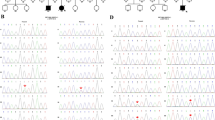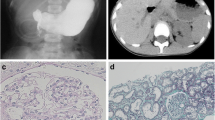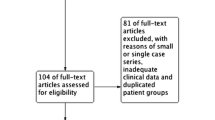Abstract
Hirschsprung disease (HSCR) is a developmental disorder characterized by the absence of ganglion cells along variable lengths of the distal gastrointestinal tract. The major susceptibility gene for the disease is the RET proto-oncogene, which encodes a receptor tyrosine kinase activated by the glial cell-derived neurotrophic factor (GDNF) family ligands. We analyzed the coding sequence of GDNF, NTRN, and, for the first time, ARTN and PSPN in HSCR patients and detected several novel variants potentially involved in the pathogenesis of HSCR. In vitro functional analysis revealed that the variant R91C in PSPN would avoid the correct expression and secretion of the mature protein. Moreover, this study also highlighted the role of both this variant and F127L in NRTN in altering RET activation by a significant reduction in phosphorylation. To support the role of PSPN R91C in HSCR phenotype, enteric nervous system (ENS) progenitors were isolated from human postnatal gut tissues and expression of GFRα4, the main co-receptor for PSPN, was demonstrated. This suggests that not only GDNF and NRTN but also PSPN might promote survival of precursor cells during ENS development. In summary, we report for the first time the association of PSPN gene with HSCR and confirm the involvement of NRTN in the disease, with the identification of novel variants in those genes. Our results suggest that the biological consequence of the mutations NTRN F127L and PSPN R91C would be a reduction in the activation of RET-dependent signaling pathways, leading to a defect in the proliferation, migration, and/or differentiation process of neural crest cells within the developing gut and thus to the typical aganglionosis of the HSCR phenotype.



Similar content being viewed by others
References
Chakravarti A, Lyonnet S (2002) Hirschsprung disease. In: Scriver CS et al (eds) The metabolic and molecular bases of inherited disease. McGraw-Hill, New York, pp 6231–6255
Amiel J, Sproat-Emison E, Garcia-Barcelo M, Lantieri F, Burzynski G, Borrego S, Pelet A, Arnold S, Miao X, Griseri P, Hirschsprung Disease Consortium et al (2008) Hirschsprung disease, associated syndromes and genetics: a review. J Med Genet 45:1–14
Emison ES, McCallion AS, Kashuk CS, Bush RT, Grice E, Lin S, Portnoy ME, Cutler DJ, Green ED, Chakravarti A (2005) A common sex-dependent mutation in a RET enhancer underlies Hirschsprung disease risk. Nature 434:857–863
Takahashi M (2001) The GDNF/RET signaling pathway and human diseases. Cytokine Growth Factor Rev 12:361–373
Airaksinen MS, Saarma M (2002) The GDNF family: signalling, biological functions and therapeutic value. Nat Rev Neurosci 3:383–394
Enokido Y, de Sauvage F, Hongo JA, Ninkina N, Rosenthal A, Buchman VL, Davies AM (1998) GFR alpha-4 and the tyrosine kinase Ret form a functional receptor complex for persephin. Curr Biol 8:1019–1022
Masure S, Cik M, Hoefnagel E, Nosrat CA, Van der Linden I, Scott R, Van Gompel P, Lesage AS, Verhasselt P, Ibáñez CF et al (2000) Mammalian GFRalpha-4, a divergent member of the GFRalpha family of coreceptors for glial cell line-derived neurotrophic factor family ligands, is a receptor for the neurotrophic factor persephin. J Biol Chem 275:39427–39434
Sidorova YA, Mätlik K, Paveliev M, Lindahl M, Piranen E, Milbrandt J, Arumäe U, Saarma M, Bespalov MM (2010) Persephin signaling through GFRalpha1: the potential for the treatment of Parkinson’s disease. Mol Cell Neurosci 44:223–232
Taraviras S, Marcos-Gutierrez CV, Durbec P, Jani H, Grigoriou M, Sukumaran M, Wang LC, Hynes M, Raisman G, Pachnis V (1999) Signalling by the RET receptor tyrosine kinase and its role in the development of the mammalian enteric nervous system. Development 126:2785–2797
Natarajan D, Marcos-Gutierrez C, Pachnis V, de Graaff E (2002) Requirement of signalling by receptor tyrosine kinase RET for the directed migration of enteric nervous system progenitor cells during mammalian embryogenesis. Development 129:5151–5160
Schuchardt A, D’Agati V, Larsson-Blomberg L, Costantini F, Pachnis V (1994) Defects in the kidney and enteric nervous system of mice lacking the tyrosine kinase receptor Ret. Nature 367:380–383
Moore MW, Klein RD, Fariñas I, Sauer H, Armanini M, Phillips H, Reichardt LF, Ryan AM, Carver-Moore K, Rosenthal A (1996) Renal and neuronal abnormalities in mice lacking GDNF. Nature 382:76–79
Cacalano G, Fariñas I, Wang LC, Hagler K, Forgie A, Moore M, Armanini M, Phillips H, Ryan AM, Reichardt LF et al (1998) GFRalpha1 is an essential receptor component for GDNF in the developing nervous system and kidney. Neuron 21:53–62
Heuckeroth RO, Enomoto H, Grider JR, Golden JP, Hanke JA, Jackman A, Molliver DC, Bardgett ME, Snider WD, Johnson EM Jr et al (1999) Gene targeting reveals a critical role for neurturin in the development and maintenance of enteric, sensory, and parasympathetic neurons. Neuron 22:253–263
Rossi J, Luukko K, Poteryaev D, Laurikainen A, Sun YF, Laakso T, Eerikäinen S, Tuominen R, Lakso M, Rauvala H et al (1999) Retarded growth and deficits in the enteric and parasympathetic nervous system in mice lacking GFR alpha2, a functional neurturin receptor. Neuron 22:243–252
Uesaka T, Enomoto H (2010) Neural precursor death is central to the pathogenesis of intestinal aganglionosis in Ret hypomorphic mice. J Neurosci 30:5211–5218
Angrist M, Bolk S, Halushka M, Lapchak PA, Chakravarti A (1996) Germline mutations in glial cell line-derived neurotrophic factor (GDNF) and RET in a Hirschsprung disease patient. Nat Genet 14:341–344
Ivanchuk SM, Myers SM, Eng C, Mulligan LM (1996) De novo mutation of GDNF, ligand for the RET/GDNFR-alpha receptor complex, in Hirschsprung disease. Hum Mol Genet 5:2023–2026
Salomon R, Attie T, Pelet A, Bidaud C, Eng C, Amiel J, Sarnacki S, Goulet O, Ricour C, Nihoul-Fekete C et al (1996) Germline mutations of the RET ligand GDNF are not sufficient to cause Hirschsprung disease. Nat Genet 14:345–347
Hofstra RM, Osinga J, Buys CH (1997) Mutations in Hirschsprung disease: when does a mutation contribute to the phenotype. Eur J Hum Genet 5:180–185
Hofstra RM, Wu Y, Stulp RP, Elfferich P, Osinga J, Maas SM, Siderius L, Brooks AS, vd Ende JJ, Heydendael VM et al (2000) RET and GDNF gene scanning in Hirschsprung patients using two dual denaturing gel systems. Hum Mutat 15:418–429
Doray B, Salomon R, Amiel J, Pelet A, Touraine R, Billaud M, Attie T, Bachy B, Munnich A, Lyonnet S (1998) Mutation of the RET ligand, neurturin, supports multigenic inheritance in Hirschsprung disease. Hum Mol Genet 7:1449–1452
Lindahl M, Poteryaev D, Yu L, Arumae U, Timmusk T, Bongarzone I, Aiello A, Pierotti MA, Airaksinen MS, Saarma M (2001) Human glial cell line-derived neurotrophic factor receptor alpha 4 is the receptor for persephin and is predominantly expressed in normal and malignant thyroid medullary cells. J Biol Chem 276:9344–9351
Ruiz-Ferrer M, Fernández RM, Antiñolo G, López-Alonso M, Eng C, Borrego S (2006) A complex additive model of inheritance for Hirschsprung disease is supported by both RET mutations and predisposing RET haplotypes. Genet Med 8:704–710
Ruiz-Ferrer M, Fernández RM, Antiñolo G, Lopez-Alonso M, Borrego S (2008) NTF-3, a gene involved in the enteric nervous system development, as a candidate gene for Hirschsprung disease. J Pediatr Surg 43:1308–1311
Fernández RM, Sánchez-Mejías A, Mena MD, Ruiz-Ferrer M, López-Alonso M, Antiñolo G, Borrego S (2009) A novel point variant in NTRK3, R645C, suggests a role of this gene in the pathogenesis of Hirschsprung disease. Ann Hum Genet 73:19–25
Sánchez-Mejías A, Fernández RM, López-Alonso M, Antiñolo G, Borrego S (2010) New roles of EDNRB and EDN3 in the pathogenesis of Hirschsprung disease. Genet Med 12:39–43
Sánchez-Mejías A, Watanabe Y, Fernández RM, López-Alonso M, Antiñolo G, Bondurand N, Borrego S (2010) Involvement of SOX10 in the pathogenesis of Hirschsprung disease: report of a truncating mutation in an isolated patient. J Mol Med 88:507–514
Eketjäll S, Ibanez CF (2002) Functional characterization of mutations in the GDNF gene of patients with Hirschsprung disease. Hum Mol Genet 11:325–329
Borghini S, Bocciardi R, Bonardi G, Matera I, Santamaria G, Ravazzolo R, Ceccherini I (2002) Hirschsprung associated GDNF mutations do not prevent RET activation. Eur J Hum Genet 10:183–187
Suter U, Heymach JV Jr, Shooter EM (1991) Two conserved domains in the NGF propeptide are necessary and sufficient for the biosynthesis of correctly processed and biologically active NGF. EMBO J 10:2395–2400
Baloh RH, Tansey MG, Johnson EM Jr, Milbrandt J (2000) Functional mapping of receptor specificity domains of glial cell line-derived neurotrophic factor (GDNF) family ligands and production of GFRalpha1 RET-specific agonists. J Biol Chem 275:3412–3420
Chen ZY, He ZY, He C, Lu CL, Wu XF (2000) Human glial cell-line-derived neurotrophic factor: a structure–function analysis. Biochem Biophys Res Commun 268:692–696
Milbrandt J, de Sauvage FJ, Fahrner TJ, Baloh RH, Leitner ML, Tansey MG, Lampe PA, Heuckeroth RO, Kotzbauer PT, Simburger KS et al (1998) Persephin, a novel neurotrophic factor related to GDNF and neurturin. Neuron 20:245–253
Yang J, Lindahl M, Lindholm P, Virtanen H, Coffey E, Runeberg-Roos P, Saarma M (2004) PSPN/GFRalpha4 has a significantly weaker capacity than GDNF/GFRalpha1 to recruit RET to rafts, but promotes neuronal survival and neurite outgrowth. FEBS Lett 569:267–271
Emison ES, Garcia-Barcelo M, Grice EA, Lantieri F, Amiel J, Burzynski G, Fernandez RM, Hao L, Kashuk C, West K et al (2010) Differential contributions of rare and common, coding and noncoding ret mutations to multifactorial Hirschsprung disease liability. Am J Hum Genet 87:60–74
Acknowledgments
We would like to thank the patients and families that participated in this study. We also thank Dr. Borghini (from Dr. Ceccherini’s lab, Instituto G Gaslini) for providing the SK-N-MC cell line stably transfected with RET cDNA, Dr. Saarma (University of Helsinki) for the GFRα4 expression vector, and Dr. Bocciardi (Instituto G Gaslini) for technical assistance. This work was supported by Fondo de Investigación Sanitaria, Spain (PI070080 and PI071315 for the E-Rare project) and Consejería de Innovación Ciencia y Empresa (CTS 2590). The CIBER de Enfermedades Raras is an initiative of the ISCIII.
Disclosure of potential conflict of interests
The authors declare no conflict of interests related to this study.
Author information
Authors and Affiliations
Corresponding author
Rights and permissions
About this article
Cite this article
Ruiz-Ferrer, M., Torroglosa, A., Luzón-Toro, B. et al. Novel mutations at RET ligand genes preventing receptor activation are associated to Hirschsprung’s disease. J Mol Med 89, 471–480 (2011). https://doi.org/10.1007/s00109-010-0714-2
Received:
Revised:
Accepted:
Published:
Issue Date:
DOI: https://doi.org/10.1007/s00109-010-0714-2




